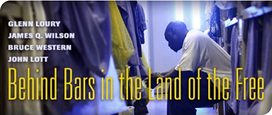In his reply to me, John Lott’s discussion of racial disparity points to several points of agreement, and perhaps one fundamental disagreement. Lott discounts studies of racial disparity of the kind that James Q. Wilson and I rely on in our discussions. The basic facts, however, are not disputed: The racial disparity unattributable to measures of crime grew from 20 percent in 1979 to 40 percent in 2009.
Lott indicates three factors which could account for the unexplained gap: (1) “racism in the criminal justice system” which he, oddly, attributes to me, (2) blacks are punished more severely than whites for the same crimes because they have more prior arrests, and (3) within broad offense categories, blacks commit crimes that are punished more severely.
Lott misses the key point, however. To account for the doubling of the unexplained racial gap in imprisonment, something about these factors must have changed. Maybe the racial gap in prior arrests has increased, maybe “racism in the criminal justice system” has increased. I’m not sure what Lott’s theory is here.
There are many other reasons why the unexplained racial disparity in imprisonment may have grown in addition to the three reasons that Lott considers. The criminal law has changed, proliferating aggravating factors in urban areas (e.g., proximity to schools), introducing new public order offenses, providing mandatory prison sentences for drug and other offenses, lengthening sentences for serious violence, and adding sentence enhancements for repeat offenders. All these changes disparately affect African Americans. Blacks with little schooling have also become worse off relative to whites. Young, low-education, black men now have relatively lower employment rates and fewer family supports than in the late 1970s. A good job and supportive family favorably influence decisions about pretrial incarceration, sentencing, parole release, and revocation. Thus, deepening social disadvantage translates into more prison time.
There’s also a larger context that’s missing. The drug arrest rate for blacks skyrocketed through the 1980s then remained at a relatively high level, while the drug arrest rate for whites increased only a little. This surely did produce a large pool of black men with an arrest and felony history, liable for imprisonment and sentence enhancements. Here, I think, Lott and I may agree. However, the driver of narcotics arrest rates in the 1980s was not crime, but a clear change in the policy — the war on drugs.
To pick up the Loury-Wilson thread, our most fundamental disagreement concerns the underlying assumption that racial inequality in incarceration would be justified by racial differences in criminal offending. I disagree, because the negative effects of incarceration threaten public safety and perpetuate social inequality. The massive investment in imprisonment, focused on poor African American communities has not served those communities well. Despite massive correctional expenditures, the urban poor — disparately African American and poorly educated — have neither greatly diminished in number nor moved closer to the social mainstream. Spending less on prisons, and more on early-child programs, as Wilson suggests, is a good step. Still, the adult men that fill the prisons are parents too, and they cannot be left out of the equation as we try to break the cycle of enduring disadvantage.

